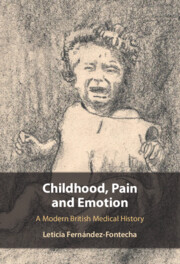Refine search
Actions for selected content:
268 results
Dexmedetomidine administration is associated with small haemodynamic changes in children undergoing cardiac procedures: a systematic review and meta-analysis
-
- Journal:
- Cardiology in the Young / Volume 35 / Issue 11 / November 2025
- Published online by Cambridge University Press:
- 24 November 2025, pp. 2321-2326
-
- Article
-
- You have access
- Open access
- HTML
- Export citation
Does the level of surgical training influence tonsillectomy outcomes? A prospective randomised study
-
- Journal:
- The Journal of Laryngology & Otology , First View
- Published online by Cambridge University Press:
- 04 November 2025, pp. 1-4
-
- Article
- Export citation
Chapter 22 - Moving from Models of Liaison Psychiatry to Psychological Medicine: New Approaches
-
-
- Book:
- Seminars in Child and Adolescent Psychiatry
- Published online:
- 10 October 2025
- Print publication:
- 30 October 2025, pp 339-352
-
- Chapter
- Export citation
Resolution of late-onset bigeminy following percutaneous transcatheter balloon valvuloplasty of the aortic valve stenosis in paediatric
-
- Journal:
- Cardiology in the Young / Volume 35 / Issue 10 / October 2025
- Published online by Cambridge University Press:
- 06 October 2025, pp. 2175-2177
-
- Article
- Export citation
Creating and implementing a novel international interprofessional bootcamp in paediatric cardiac critical care
-
- Journal:
- Cardiology in the Young / Volume 35 / Issue 10 / October 2025
- Published online by Cambridge University Press:
- 25 September 2025, pp. 1999-2004
-
- Article
- Export citation
Little lives—reading between the lines: insights from the Northampton Infirmary Eighteenth Century Child Admission Database
-
- Journal:
- Medical History / Volume 69 / Issue 3 / July 2025
- Published online by Cambridge University Press:
- 22 August 2025, pp. 374-392
-
- Article
-
- You have access
- Open access
- HTML
- Export citation
The hidden seasonality of pharyngitis and tonsillitis: a recurring early-summer wave of unclear aetiology
-
- Journal:
- Epidemiology & Infection / Volume 153 / 2025
- Published online by Cambridge University Press:
- 15 August 2025, e99
-
- Article
-
- You have access
- Open access
- HTML
- Export citation
A rare case of cutaneous vascular phenomena and fulminant cardiac involvement in paediatric multisystem inflammatory syndrome in children following asymptomatic COVID-19 exposure in a 7-year-old child
-
- Journal:
- Cardiology in the Young / Volume 35 / Issue 7 / July 2025
- Published online by Cambridge University Press:
- 11 August 2025, pp. 1482-1486
-
- Article
- Export citation
Safety of direct oral anticoagulants in surgical bioprosthetic heart valves: a paediatric institution’s experience
-
- Journal:
- Cardiology in the Young / Volume 35 / Issue 8 / August 2025
- Published online by Cambridge University Press:
- 11 August 2025, pp. 1631-1636
-
- Article
- Export citation
Real-world use of intravenous iron sucrose in children with cardiac disease
-
- Journal:
- Cardiology in the Young / Volume 35 / Issue 7 / July 2025
- Published online by Cambridge University Press:
- 31 July 2025, pp. 1344-1349
-
- Article
- Export citation
22q.11: a Risk Factor for Left Pulmonary Artery Hypoplasia in Congenital Heart Disease
-
- Journal:
- Cardiology in the Young / Volume 35 / Issue 7 / July 2025
- Published online by Cambridge University Press:
- 28 July 2025, pp. 1377-1381
-
- Article
- Export citation
Severe hyperlactatemia from Warburg effect due to post-transplant lymphoproliferative disorder after paediatric heart transplantation with resolution following thiamine administration
-
- Journal:
- Cardiology in the Young / Volume 35 / Issue 6 / June 2025
- Published online by Cambridge University Press:
- 21 May 2025, pp. 1287-1289
-
- Article
- Export citation
2 - Infant Pain Denial
-
- Book:
- Childhood, Pain and Emotion
- Published online:
- 21 March 2025
- Print publication:
- 03 April 2025, pp 57-78
-
- Chapter
- Export citation
Introduction
-
- Book:
- Childhood, Pain and Emotion
- Published online:
- 21 March 2025
- Print publication:
- 03 April 2025, pp 1-20
-
- Chapter
- Export citation
1 - The Language of Children’s Pain
-
- Book:
- Childhood, Pain and Emotion
- Published online:
- 21 March 2025
- Print publication:
- 03 April 2025, pp 21-56
-
- Chapter
- Export citation

Childhood, Pain and Emotion
- A Modern British Medical History
-
- Published online:
- 21 March 2025
- Print publication:
- 03 April 2025
Markers of growth and nutrition in children with acquired chylothorax post CHD surgery
-
- Journal:
- Cardiology in the Young / Volume 35 / Issue 4 / April 2025
- Published online by Cambridge University Press:
- 03 March 2025, pp. 791-797
-
- Article
-
- You have access
- Open access
- HTML
- Export citation
Arterial thromboembolism, antithrombotic therapy, and risk of recurrent thromboembolism in children with CHD undergoing cardiac surgery
-
- Journal:
- Cardiology in the Young / Volume 35 / Issue 4 / April 2025
- Published online by Cambridge University Press:
- 27 February 2025, pp. 679-682
-
- Article
-
- You have access
- Open access
- HTML
- Export citation
Chapter 39 - Trauma in Children
-
-
- Book:
- Core Topics in Paediatric Anaesthesia
- Published online:
- 06 February 2025
- Print publication:
- 13 February 2025, pp 440-455
-
- Chapter
- Export citation
Achieving excellence in paediatric cardiac care in resource limited and resource plentiful settings and building successful care networks across different countries
-
- Journal:
- Cardiology in the Young / Volume 34 / Issue 11 / November 2024
- Published online by Cambridge University Press:
- 09 January 2025, pp. 2279-2289
-
- Article
-
- You have access
- Open access
- HTML
- Export citation
